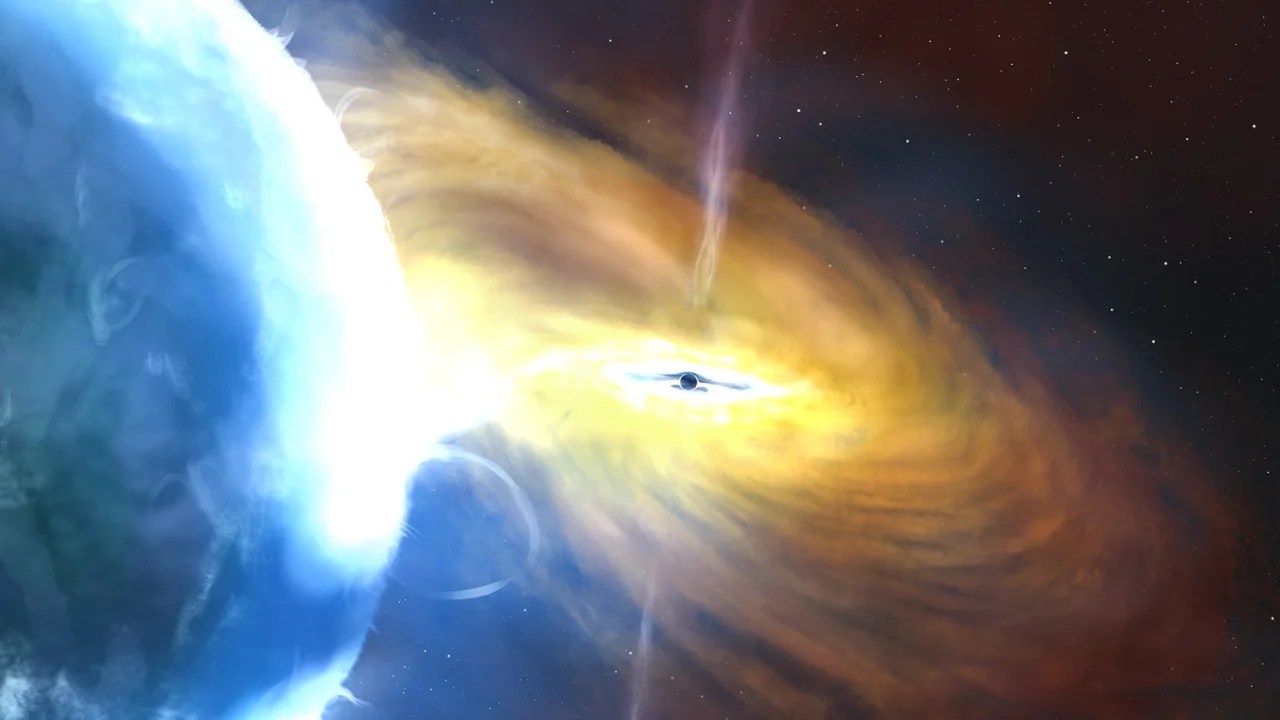(CNN) – Astronomers have detected the largest cosmic explosion ever recorded, ten times brighter than any known exploding star or supernova.
The flare from the explosion, called AT2021lwx, lasted for three years, while most supernovae only glow for a few months.
This phenomenon, which is still being detected by telescopes, occurred about 8 billion light-years from Earth when the universe was about 6 billion years old. The brightness of the explosion is also three times brighter compared to other events such as stars falling into supermassive black holes.
But what caused such a huge, long-lasting cosmic explosion? Astronomers said they believe a supermassive black hole has disrupted a large cloud of gas or dust, which is likely thousands of times more massive than our sun. According to the researchers, it is likely that the cloud deviated from the path of its orbit and headed towards the black hole.
As the black hole swallowed pieces of the hydrogen cloud, the shock waves echoed through the remnants of the cloud and into the swirling mass of material orbiting the black hole.
AT2021lwx event remove throne GRB 221009A gamma ray burst As the brightest cosmic explosion on record, it was reported in 2022. The gamma-ray burst was actually much brighter, but it only lasted for a fraction of AT2021lwx, which releases more energy overall.
The results were published on Thursday Monthly Notices of the Royal Astronomical Society.
This illustration shows a growing black hole devouring gas, dust, and other cosmic matter. Credit: John A Paice
Astronomers first detected the explosion in November 2020 at the Zwicky Transit Facility in California, followed by the Last Impact Alert System in Hawaii a few months later. Both observe objects in the night sky that are rapidly changing in brightness, such as exploding stars, asteroids, and comets.
“We came across this by chance, our search algorithm flagged it when we were looking for some kind of supernova,” said the study’s lead author, Dr. Philip Wiseman, a researcher at the University of Southampton in England, in a statement. “Most supernovae and tidal disturbance events only last a couple of months before fading. For something to stay bright for more than two years was immediately unusual.”
Follow-up observations were made using the Neil Gehrels Swift Space Observatory, the New Technology Telescope in Chile, and the Gran Canaria Telescope in La Palma, Spain.
The researchers were able to determine the distance between Earth and the event by analyzing the different wavelengths of light used to observe the explosion.
“Once you know the distance to the object and how bright it is to us, you can calculate the object’s brightness from its source,” study co-author Sebastian Honig, a professor at the University of Southampton, said in a statement.
The Earth’s Asteroid Last Warning System has observed the blast every few nights for the past two and a half years.
The research team determined that the incredibly luminous event was roughly 100 times brighter than the 100 billion stars in the Milky Way combined.
The only celestial objects that rival the brightness of AT2021lwx are quasars, or supermassive black holes that are constantly feeding off high-velocity gas.
“With a quasar, we see the brightness go up and down over time,” study co-author Mark Sullivan, a professor at the University of Southampton, said in a statement. “But looking back more than a decade, there was no detection of AT2021lwx, and then suddenly it appeared as bright as the brightest object in the universe, which is unprecedented.”
The team had initial theories by studying the brightness of the explosion. The researchers now want to collect more data with different wavelengths of light to learn the details of the event, including its temperature.
“At first, we thought this glow might be the result of a black hole devouring a passing star. But our models showed that a black hole would have to swallow 15 times the mass of our Sun to stay bright for that long,” said study co-author Dr. Matt Nichol, associate professor at UT. Queen’s Belfast in Ireland. in the current situation.
“It is very rare to find such a large star, so we think a much larger gas cloud is more likely. Many massive black holes are surrounded by gas and dust and we are still trying to figure out why this particular black hole suddenly started feeding so hard.”

“Proud web fanatic. Subtly charming twitter geek. Reader. Internet trailblazer. Music buff.”

:quality(85)/cloudfront-us-east-1.images.arcpublishing.com/infobae/TEQF6EONZRFGLLLDIDD4L2O4EE.jpg)

:quality(75)/cloudfront-us-east-1.images.arcpublishing.com/elcomercio/XU32LRAEZFDDPNVHLFU3CKVBYY.jpg)



More Stories
How to create 3D videos with my iPhone, it will be very useful even for your business
NASA discovers an anomaly in the Earth’s magnetic field that could have serious consequences for humans
Can the Earth be divided into two parts?